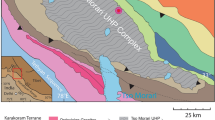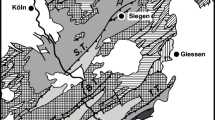Abstract.
Metamorphic index mineral zones, pressure–temperature (P–T) conditions, and CO2–H2O fluid compositions were determined for metacarbonate layers within the Wepawaug Schist, Connecticut, USA. Peak metamorphic conditions were attained in the Acadian orogeny and increase from ~420 °C and ~6.5 kb in the low-grade greenschist facies to ~610 °C and ~9.5 kb in the amphibolite facies. The index minerals oligoclase, biotite, calcic amphibole, and diopside formed with progressive increases in metamorphic intensity. In the upper greenschist facies and in the amphibolite facies, prograde reaction progress is greatest along the margins of metacarbonate layers in contact with surrounding schists, or in reaction selvages bordering syn-metamorphic quartz veins. New index minerals typically appear first in these more highly reacted contact and selvage zones. It has been postulated that this spatial zonation of mineral assemblages resulted from infiltration, largely by diffusion, of water-rich fluids across lithologic contacts or away from fluid conduits like fractures. In this model, the infiltrating fluids drove prograde CO2 loss and were derived from surrounding dehydrating schists or sources external to the metasedimentary sequence. The model predicts that significant gradients in the mole fraction of CO2 (\(X_{CO_2 } \) ) should have been present during metamorphism, but new estimates of fluid composition indicate that differences in \(X_{CO_2 } \) preserved across layers or vein selvages were very small, ~0.02 or less. However, analytical solutions to the two-dimensional advection–dispersion-reaction equation show that only small fluid composition gradients across layers or selvages are needed to drive prograde CO2 loss by diffusion and mechanical dispersion. These gradients, although typically too small to be measured by field-based techniques, would still be large enough to dominate the effects of fluid flow and reaction along regional T and P gradients. Larger gradients in fluid composition may have existed across some layers during metamorphism, but large gradients favor rapid reaction and would, therefore, seldom be preserved in the rock record. Most of the H2O needed to drive prograde CO2 loss probably came from regional dehydration of surrounding metapelitic schists, although H2O-rich diopside zone conditions may have also required an external fluid component derived from syn-metamorphic intrusions or the metavolcanic rocks that structurally underlie the Wepawaug Schist.
Similar content being viewed by others
Author information
Authors and Affiliations
Additional information
Electronic Publication
Rights and permissions
About this article
Cite this article
Ague, J.J. Gradients in fluid composition across metacarbonate layers of the Wepawaug Schist, Connecticut, USA. Contrib Mineral Petrol 143, 38–55 (2002). https://doi.org/10.1007/s00410-001-0330-9
Received:
Accepted:
Issue Date:
DOI: https://doi.org/10.1007/s00410-001-0330-9




